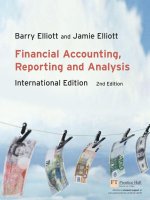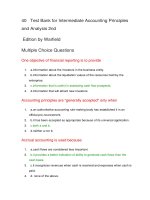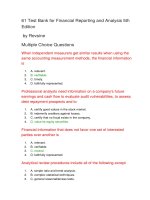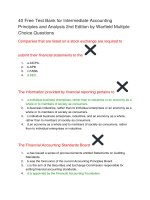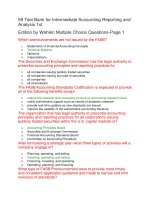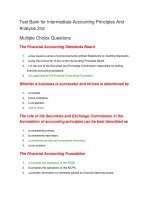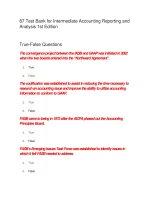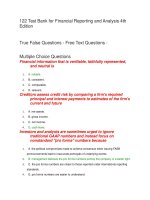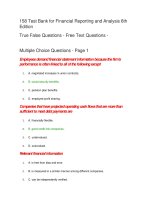Ebook Financial accounting, reporting and analysis (2nd edition) Part 1
Bạn đang xem bản rút gọn của tài liệu. Xem và tải ngay bản đầy đủ của tài liệu tại đây (3.41 MB, 343 trang )
027370253X_COVER
18/10/05
10:40 AM
Page 1
www.downloadslide.com
The fully updated International Edition of Elliott and Elliott’s market-leading
Financial Accounting and Reporting uses the latest International Accounting
Standards as its framework. It offers a unique balance of theoretical and
conceptual coverage with up-to-date practical applications and illustrations
taken from real world international company reports and accounts. The text
is ideal for financial accounting, reporting and analysis modules on second
and final year undergraduate courses in accounting, business studies and
combined studies. It is also suitable for MBA courses, specialist MSc courses
and professional courses preparing students for accountancy examinations.
Key features:
• Completely updated in line with IFRSs and the application of international standards
worldwide.
• New pedagogical features including key points, overviews, chapter objectives and learning
outcomes, summaries and further questions.
• Widespread inclusion of contemporary international case studies.
• Attractive new two-colour design. Illustrations taken from real published accounts to
demonstrate the practical application and limitations of the subject.
• Excellent range of review questions for use in seminars or for revision purposes.
• Exercises of varying difficulty with solutions to selected exercises provided at the back of
the book.
• Extensive references included at the end of each chapter.
• Supported by an Instructor’s Manual containing fully worked solutions to all exercises in
the book.
Barry Elliott is a training consultant. He has extensive teaching experience at
undergraduate, postgraduate and professional level in China, Hong Kong,
New Zealand and Singapore. He has wide experience as an external
examiner both in higher education and at all levels of professional education.
Financial Accounting, Reporting and Analysis
International Edition
Financial Accounting, Reporting and Analysis
2nd Edition
International Edition
2nd
Edition
Barry Elliott and Jamie Elliott
Financial Accounting,
Reporting and Analysis
International Edition
2nd Edition
Elliott
Jamie Elliott is a Director with Deloitte & Touche. Prior to this he has
lectured at university on undergraduate degree programmes and as an
assistant professor on MBA and executive programmes at the London
Business School.
and
Elliott
Cover image © Alamy Images
An imprint of
Additional student support at
www.pearsoned.co.uk/elliott_elliott
www.pearson-books.com
Additional student support at
www.pearsoned.co.uk/elliott_elliott
FAR_A01.QXD
27/10/05
11:51
Page i
www.downloadslide.com
Financial Accounting, Reporting
and Analysis: International Edition
Visit the Financial Accounting, Reporting and Analysis:
International Edition (2nd Edition) Companion Website at
www.pearsoned.co.uk/elliott_elliott
to find valuable student learning material including:
• Extracts from the financial press
• Multiple choice questions to test your learning
• Case studies with solutions
FAR_A01.QXD
27/10/05
11:51
Page ii
www.downloadslide.com
We work with leading authors to develop the
strongest educational materials in accounting,
bringing cutting-edge thinking and best learning
practice to a global market.
Under a range of well-known imprints, including
Financial Times Prentice Hall, we craft high-quality
print and electronic publications which help readers
to understand and apply their content, whether
studying or at work.
To find out more about the complete range of our
publishing please visit us on the World Wide Web at:
www.pearsoned.co.uk
FAR_A01.QXD
27/10/05
11:51
Page iii
www.downloadslide.com
Financial Accounting,
Reporting and Analysis:
International Edition
2nd Edition
Barry Elliott and Jamie Elliott
FAR_A01.QXD
27/10/05
11:51
Page iv
www.downloadslide.com
Pearson Education Limited
Edinburgh Gate
Harlow
Essex CM20 2JE
England
and Associated Companies throughout the world
Visit us on the World Wide Web at:
www.pearsoned.co.uk
First published 2002
Second edition 2006
© Pearson Education Limited 2002, 2006
The rights of Barry Elliott and Jamie Elliott to be identified as authors of this
work have been asserted by them in accordance with the Copyright, Designs,
and Patents Act 1988.
All rights reserved. No part of this publication may be reproduced, stored in
a retrieval system, or transmitted in any form or by any means, electronic,
mechanical, photocopying, recording, or otherwise, without either the prior
written permission of the Publishers or a licence permitting restricted copying
in the United Kingdom issued by the Copyright Licensing Agency Ltd,
90 Tottenham Court Road, London W1T 4LP.
ISBN-13: 978-0-273-70253-5
ISBN-10: 0-27370-253-X
British Library Cataloguing-in-Publication Data
A catalogue record for this book is available from the British Library.
Library of Congress Cataloging-in-Publication Data
A catalog record for this book is available from the Library of Congress.
10 9 8 7 6 5 4 3 2 1
10 09 08 07 06
Typeset in 9/12pt Ehrhardt by 25.
Printed by Ashford Colour Press Ltd., Gosport.
The publisher’s policy is to use paper manufactured from sustainable forests.
FAR_A01.QXD
27/10/05
11:51
Page v
www.downloadslide.com
Brief Contents
Preface and acknowledgements
Part 1
REGULATORY FRAMEWORK – AN ATTEMPT TO ACHIEVE
UNIFORMITY
1 Financial reporting – evolution of international standards
2 Conceptual framework
3 Published accounts of companies
4 Preparation of published accounts
xviii
1
3
24
49
94
Part 2
BALANCE SHEET – EQUITY, LIABILITY AND ASSET
MEASUREMENT AND DISCLOSURE
117
5
6
7
8
9
10
11
12
13
14
119
144
171
190
212
239
271
291
322
345
Share capital, distributable profits and reduction of capital
Off balance sheet finance
Financial instruments
Employee benefits
Taxation in company accounts
Property, plant and equipment (PPE)
Leasing
R&D; goodwill and intangible assets; brands
Inventories
Construction contracts
Part 3 CONSOLIDATED ACCOUNTS
361
15
16
17
18
19
363
380
392
410
425
Accounting for groups at the date of acquisition
Preparation of consolidated balance sheets after the date of acquisition
Preparation of consolidated income statements
Accounting for associated companies
Accounting for the effects of changes in foreign exchange rates under IAS 21
FAR_A01.QXD
27/10/05
11:51
Page vi
www.downloadslide.com
vi • Brief Contents
Part 4 INTERPRETATION
443
20
21
22
23
24
445
470
495
537
577
Earnings per share
Cash flow statements
Review of financial ratio analysis
Trend analysis and multivariate analysis
An introduction to financial reporting on the Internet
Part 5 ACCOUNTABILITY
589
25 Corporate governance
26 Environmental and social reporting
27 Ethics for accountants
591
622
659
Appendix: Outline solutions to selected exercises
679
Index
685
FAR_A01.QXD
27/10/05
11:51
Page vii
www.downloadslide.com
Full Contents
Preface and acknowledgements
xviii
Part 1
REGULATORY FRAMEWORK – AN ATTEMPT TO ACHIEVE
UNIFORMITY
1 Financial reporting – evolution of international
standards
1.1
1.2
1.3
1.4
1.5
1.6
1.7
1.8
1.9
1.10
Introduction
National differences
Reasons for differences in financial reporting
Classification of national accounting systems
Attempts to reduce national differences
The work of international bodies in harmonising and standardising
financial reporting
Arguments in support of standards
Arguments against standards
US GAAP
Reconciliations and supplementary statements
Summary
Review questions
Exercises
References
2 Conceptual framework
2.1
2.2
2.3
2.4
2.5
2.6
Introduction
Historical overview of the evolution of financial accounting theory
IASC Framework for the Presentation and Preparation of Financial Statements
ASB Statement of Principles 1999
AICPA Improving Business Reporting – A Customer Focus:
Meeting the Information Needs of Investors and Creditors
ICAS Making Corporate Reports Valuable
Summary
Review questions
Exercises
References
1
3
3
3
4
8
9
9
16
17
18
20
21
21
21
22
24
24
25
28
30
40
41
42
44
45
48
FAR_A01.QXD
27/10/05
11:51
Page viii
www.downloadslide.com
viii • Full Contents
3 Published accounts of companies
3.1
3.2
3.3
3.4
3.5
3.6
3.7
3.8
3.9
3.10
3.11
3.12
3.13
3.14
3.15
3.16
3.17
3.18
3.19
3.20
3.21
3.22
Introduction
A public company’s financial calendar
Criteria for information appearing in a published income statement
and balance sheet
The prescribed formats – the income statement
What information is required to be disclosed in Format 1 and
Format 2?
Cost of sales
Distribution costs
Administrative expenses
Other income
What costs and income are brought into account after calculating
the trading profit in order to arrive at the profit on ordinary activities
before tax?
Does it really matter under which heading a cost is classified in the
income statement provided it is not omitted?
Discontinued operations disclosure in the income statement
Items requiring separate disclosure
The prescribed formats – the balance sheet
Statement of changes in equity
Reporting comprehensive income
Segment reporting
The fundamental accounting principles underlying the published income
statement and balance sheet
Disclosure of accounting policies
Fair view treatment
Additional information in the annual report
What information do companies provide to assist comparison
between companies reporting under different reporting regimes?
Summary
Review questions
Exercises
References
4 Preparation of published accounts
4.1
4.2
4.3
4.4
4.5
4.6
4.7
Introduction
Stage 1: preparation of the internal income statement from a trial
balance
Stage 2: preparation of the income statement of Illustrious SpA in
Format 1 style
Stage 3: preparation of the balance sheet
Preparation of accounts in Format 1 following IAS 8 and IFRS 5
Additional information value of IFRS 5
Additional information value of IAS 24
Summary
Review questions
Exercises
References
49
49
50
51
51
52
53
57
57
57
57
58
58
61
61
65
67
70
71
71
76
78
80
84
84
86
93
94
94
94
96
99
100
104
105
107
108
109
116
FAR_A01.QXD
27/10/05
11:51
Page ix
www.downloadslide.com
Full Contents • ix
Part 2
BALANCE SHEET – EQUITY, LIABILITY AND ASSET
MEASUREMENT AND DISCLOSURE
117
5
119
Share capital, distributable profits and reduction of capital
5.1
5.2
5.3
5.4
5.5
5.6
5.7
5.8
5.9
5.10
5.11
5.12
5.13
5.14
6
Introduction
Total owners’ equity: an overview
Total shareholders’ funds: more detailed explanation
Accounting entries on issue of shares
Creditor protection: capital maintenance concept
Creditor protection: why capital maintenance rules are necessary
Creditor protection: how to quantify the amounts available to meet
creditors’ claims
Issued share capital: minimum share capital
Distributable profits: general considerations
Distributable profits: how to arrive at the amount using relevant
accounts
When may capital be reduced?
Writing off part of capital which has already been lost and is not
represented by assets
Repayment of part of paid-in capital to shareholders or cancellation
of unpaid share capital
Purchase of own shares
Summary
Review questions
Exercises
References
Off balance sheet finance
6.1
6.2
6.3
6.4
6.5
6.6
6.7
6.8
6.9
6.10
6.11
Introduction
Primary financial statements: their interrelationship
Primary financial statements: changes in their interrelationship
Reasons that companies borrow
Capital gearing and its implications
Off balance sheet finance
Substance over form
Impact of converting to IFRS
Balance sheet as valuation document
Why companies take steps to strengthen their balance sheets
Definitions cannot remove uncertainty: IAS 10 and IAS 37
Summary
Review questions
Exercises
References
119
121
122
124
125
126
127
127
128
129
129
130
136
136
139
140
140
143
144
144
144
145
145
146
148
149
152
155
156
157
165
166
167
169
FAR_A01.QXD
27/10/05
11:51
Page x
www.downloadslide.com
x • Full Contents
7
Financial instruments
7.1
7.2
7.3
8
Employee benefits
8.1
8.2
8.3
8.4
8.5
8.6
8.7
8.8
8.9
8.10
8.11
8.12
8.13
8.14
8.15
8.16
9
Introduction
IAS 32 Financial Instruments: Disclosure and Presentation
IAS 39 Financial Instruments: Recognition and Measurement
Summary
Review questions
Exercises
References
Introduction
Financial reporting implications
Types of scheme
Defined contribution pension schemes
Defined benefit pension schemes
IAS 19 (revised) Employee Benefits
The liability for pension and other post-retirement costs
The income statement
Comprehensive illustration
Plan curtailments and settlements
Multi-employer plans
Disclosures
Other long-service benefits
Short-term benefits
Termination benefits
IAS 26 Accounting and Reporting by Retirement Benefit Plans
Summary
Review questions
Exercises
References
Taxation in company accounts
9.1
9.2
9.3
9.4
9.5
9.6
9.7
9.8
9.9
9.10
9.11
9.12
Introduction
Corporation tax
Corporation tax systems – the theoretical background
Corporation tax systems – avoidance and evasion
Corporation tax – the system from 6 April 1999
IFRS and taxation
IAS 12 – accounting for current taxation
Deferred tax
FRS 19 (the UK standard on deferred taxation)
A critique of deferred taxation
Examples of companies following IAS 12
Value added tax (VAT)
Summary
Review questions
Exercises
References
171
171
171
181
187
187
188
189
190
190
191
191
193
194
196
196
199
199
201
202
202
203
203
204
205
208
208
210
211
212
212
212
213
214
216
218
219
221
228
229
232
234
235
236
236
237
FAR_A01.QXD
27/10/05
11:51
Page xi
www.downloadslide.com
Full Contents • xi
10 Property, plant and equipment (PPE)
10.1
10.2
10.3
10.4
10.5
10.6
10.7
10.8
10.9
10.10
10.11
10.12
10.13
10.14
10.15
Introduction
What is PPE?
How is the cost of PPE determined?
What is depreciation?
What are the constituents in the depreciation formula?
How is the useful life of an asset determined?
Residual value
Calculation of depreciation
Measurement subsequent to initial recognition
IAS 36 Impairment of Assets
IFRS 5 Non-Current Assets Held for Sale and Discontinued Operations
Disclosure requirements
Government grants towards the cost of PPE
Investment properties
Effect of accounting policy for PPE on the interpretation of the
financial statements
Summary
Review questions
Exercises
References
239
239
240
241
243
246
246
247
247
252
254
259
260
261
262
263
265
266
266
270
11 Leasing
271
11.1
11.2
11.3
11.4
11.5
11.6
11.7
11.8
11.9
271
271
273
275
277
282
283
284
285
286
287
288
290
Introduction
Background to leasing
IAS 17 (and its national equivalents) – the controversy
IAS 17 – classification of a lease
IAS 17 – accounting for leases by lessees
Accounting for the lease of land and buildings
Leasing – a form of off balance sheet financing
Accounting for leases – a new approach
Accounting for leases by lessors
Summary
Review questions
Exercises
References
12 R&D; goodwill and intangible assets; brands
12.1
12.2
12.3
12.4
12.5
12.6
12.7
12.8
12.9
12.10
Introduction
Accounting treatment for research and development
Research and development
Introduction to goodwill and intangible assets
Application of IAS 38 Intangible Assets
Is there a correct treatment for amortising goodwill?
Other types of intangible asset under IAS 38
Disclosure of intangible assets under IAS 38
Brand accounting
Intellectual property
Summary
Review questions
Exercises
References
291
291
291
293
297
297
301
306
307
307
309
313
314
316
320
FAR_A01.QXD
27/10/05
11:51
Page xii
www.downloadslide.com
xii • Full Contents
13 Inventories
13.1
13.2
13.3
13.4
13.5
13.6
13.7
13.8
13.9
13.10
Introduction
Inventory defined
The controversy
IAS 2 Inventories
Inventory valuation
Work-in-progress
Inventory control
Creative accounting
Audit of the year-end physical inventory count
Published accounts
Summary
Review questions
Exercises
References
14 Construction contracts
14.1
14.2
14.3
14.4
14.5
Introduction
Identification of contract revenue
Identification of contract costs
Recognition of contract revenue and expenses
Public-private partnerships (PPPs)
Summary
Review questions
Exercises
References
322
322
322
323
324
325
332
334
335
337
339
340
341
342
344
345
345
345
346
346
349
354
355
355
359
Part 3
CONSOLIDATED ACCOUNTS
361
15 Accounting for groups at the date of acquisition
363
15.1
15.2
15.3
15.4
15.5
15.6
15.7
15.8
Introduction
The definition of a group
Consolidated accounts and some reasons for their preparation
The definition of control
Alternative methods of preparing consolidated accounts
The treatment of positive goodwill
The treatment of negative goodwill
The comparison between an acquisition by cash and an exchange
of shares
15.9 Minority interests
15.10 The treatment of differences between a subsidiary’s fair value and
book value
15.11 How to calculate fair values
Summary
Review questions
Exercises
References
363
363
363
365
366
367
368
368
368
370
371
372
373
374
379
FAR_A01.QXD
27/10/05
11:51
Page xiii
www.downloadslide.com
Full Contents • xiii
16 Preparation of consolidated balance sheets after the date of
acquisition
16.1
16.2
16.3
16.4
16.5
16.6
16.7
Introduction
Pre- and post-acquisition profits losses
Inter-company balances
Unrealised profit on inter-company sales
Provision for unrealised profit affecting a minority
Uniform accounting policies and reporting dates
How is the investment in subsidiaries reported in the parent’s own
balance sheet?
Summary
Review questions
Exercises
References
17 Preparation of consolidated income statements
17.1
17.2
17.3
17.4
17.5
Introduction
Preparation of a consolidated income statement – the Ante Group
Dividends or interest paid by the subsidiary out of pre-acquisition
profits
A subsidiary acquired part of the way through the year
Published format income statement
Summary
Review questions
Exercises
References
18 Accounting for associated companies
18.1
18.2
18.3
18.4
18.5
18.6
18.7
380
380
380
382
384
388
388
388
388
389
389
391
392
392
392
395
396
399
399
400
400
409
410
Introduction
Definitions of associates and of significant influence
The treatment of associated companies in consolidated accounts
The Brill Group – the equity method illustrated
The treatment of provisions for unrealised profits
The acquisition of an associate part-way through the year
Joint ventures
Summary
Review questions
Exercises
References
410
410
411
411
414
414
416
417
418
418
424
19 Accounting for the effects of changes in foreign exchange
rates under IAS 21
425
19.1
19.2
19.3
19.4
19.5
19.6
Introduction
The difference between conversion and translation and the definition
of a foreign currency transaction
The functional currency
The presentation currency
Monetary and non-monetary items
The rules on the recording of foreign currency transactions
425
425
426
426
427
427
FAR_A01.QXD
27/10/05
11:51
Page xiv
www.downloadslide.com
xiv • Full Contents
19.7
19.8
19.9
19.10
19.11
19.12
19.13
The treatment of exchange differences on foreign currency
transactions
Foreign exchange transactions in the individual accounts of companies
illustrated – Boil plc
The translation of the accounts of foreign operations where the
functional currency is the same as that of the parent
Granby Ltd illustration
The use of a presentation currency other than the functional
currency
Granby Ltd illustration continued
Implications of IAS 21
Summary
Review questions
Exercises
References
427
428
429
429
436
436
438
439
439
439
441
Part 4
INTERPRETATION
443
20 Earnings per share
445
20.1
20.2
20.3
20.4
20.5
20.6
20.7
20.8
Introduction
Why is the earnings per share figure important?
How is the EPS figure calculated?
The use to shareholders of the EPS
Illustration of the basic EPS calculation
Adjusting the number of shares used in the basic EPS calculation
Rights issues
Adjusting the earnings and number of shares used in the diluted EPS
calculation
20.9 Procedure where there are several potential dilutions
20.10 Exercise of conversion rights during financial year
20.11 Disclosure requirements of IAS 33
20.12 The Improvement Project
Summary
Review questions
Exercises
References
21 Cash flow statements
21.1
21.2
21.3
21.4
21.5
21.6
21.7
Introduction
Development of cash flow statements
Applying IAS 7 (revised) Cash Flow Statements
IAS 7 (revised) format of cash flow statements
Consolidated cash flow statements
Analysing a cash flow statement
Critique of cash flow accounting
Summary
Review questions
Exercises
References
445
445
446
447
448
448
451
456
458
460
461
463
463
464
465
469
470
470
470
471
473
477
480
482
483
484
484
494
FAR_A01.QXD
27/10/05
11:51
Page xv
www.downloadslide.com
Full Contents • xv
22 Review of financial ratio analysis
22.1
22.2
22.3
22.4
22.5
22.6
22.7
22.8
22.9
22.10
22.11
22.12
Introduction
Accounting ratios and ratio analysis
Six key ratios
Description of the six key ratios
Description of subsidiary ratios
Application of pyramid of ratios to JD Wetherspoon plc
Segmental analysis
Inter-firm comparisons and industry averages
Inter-firm comparisons: JD Wetherspoon and the brewing industry
World Wide Web pages for company information
Non-financial ratios
Interpretation problems when using ratios and consolidated
financial statements
Summary
Review questions
Exercises
References
23 Trend analysis and multivariate analysis
23.1
23.2
23.3
23.4
23.5
23.6
23.7
23.8
23.9
23.10
23.11
23.12
23.13
23.14
23.15
23.16
23.17
23.18
Introduction
Horizontal analysis between two periods
Trend analysis over a series of periods
Historical summaries
Vertical analysis – common size statements
Multivariate analysis – Z-scores
H-scores
A-scores
Accounting policies
Balanced scorecards
Valuing shares of an unquoted company – quantitative process
Valuing shares of an unquoted company – qualitative process
Shareholder value analysis (SVA)
Measuring and reporting values in the annual report
Shareholder information needs
Professional risk assessors
Earnings management
Impact of differences between IASs and national standards on
trend analysis
Summary
Review questions
Exercises
References
24 An introduction to financial reporting on the Internet
24.1
24.2
24.3
24.4
Introduction
What is XBRL?
What XBRL is not
How can it be used?
495
495
496
497
499
501
507
510
516
518
520
522
522
524
525
526
536
537
537
537
539
541
541
544
546
546
548
549
550
552
553
554
559
562
564
565
566
567
569
576
577
577
578
580
580
FAR_A01.QXD
27/10/05
11:51
Page xvi
www.downloadslide.com
xvi • Full Contents
24.5
24.6
24.7
What is needed to use XBRL
Progress of XBRL
Companies currently using XBRL
Summary
Review questions
Exercises
Further reading
582
584
585
586
586
586
588
Part 5
ACCOUNTABILITY
589
25 Corporate governance
591
25.1
25.2
25.3
25.4
25.5
25.6
25.7
25.8
25.9
25.10
Introduction
The need for corporate governance guidelines
Corporate governance in different countries
Corporate governance requirements
The UK Combined Code
Directors’ remuneration
Relations with shareholders
Institutional investors
Corporate governance – summary
Auditors
Summary
Review questions
Exercises
References
26 Environmental and social reporting
26.1
26.2
26.3
26.4
26.5
26.6
26.7
26.8
26.9
26.10
26.11
26.12
26.13
26.14
26.15
26.16
Introduction
Accountants’ role in a capitalist industrial society
Sustainability
Background to companies’ reporting practices
European Commission recommendations for disclosures in
annual accounts
Evolution of stand-alone environmental reports
International charters and guidelines
Economic consequences of environmental reporting
Summary on environmental reporting
Environmental auditing: international initiatives
The activities involved in an environmental audit
Concept of social accounting
Background to social accounting
Corporate social responsibility (CSR)
Need for comparative data
International initiatives towards triple bottom line reporting
Summary
Review questions
Exercises
References
Further reading
591
591
592
594
597
597
607
607
608
609
616
616
618
621
622
622
622
623
624
625
627
628
632
632
633
634
636
638
641
642
645
648
648
650
656
657
FAR_A01.QXD
27/10/05
11:51
Page xvii
www.downloadslide.com
Full Contents • xvii
27 Ethics for accountants
27.1
27.2
27.3
27.4
27.5
27.6
27.7
27.8
Introduction
The nature of business ethics
Ethical codes for businesses
The background to business ethics
The role of ethics in modern business
The role of professional accounting ethics
The role of the accountant as guardian of business ethics
Growth of voluntary standards
Summary
Review questions
References
Bibliography
659
659
659
661
663
664
667
671
672
675
676
678
678
Appendix: Outline solutions to selected exercises
679
Index
685
Supporting resources
Visit www.pearsoned.co.uk/elliott_elliott to find valuable online resources
Companion Website for students
• Extracts from the financial press
• Multiple choice questions to test your learning
• Case studies with solutions
For instructors
• PowerPoint slides that can be downloaded and used as OHTs
• Downloadable Instructor’s Manual which includes worked solutions to all exercises
For more information please contact your local Pearson Education sales
representative or visit www.pearsoned.co.uk/elliott_elliott
FAR_A01.QXD
27/10/05
11:51
Page xviii
www.downloadslide.com
Preface and acknowledgements
Our objective is to provide a balanced and comprehensive framework to enable students
to acquire the requisite knowledge and skills to appraise current practice critically and to
evaluate proposed changes from a theoretical base. To this end, the text contains:
●
●
●
●
●
●
current standards,
illustrations from published accounts,
a range of review questions,
exercises of varying difficulty,
outline solutions to selected exercises in an Appendix at the end of the book,
extensive references.
We have assumed that readers will have an understanding of financial accounting to a
foundation or first-year level, although the text and exercises have been designed on the
basis that a brief revision is still helpful.
Lecturers are using the text selectively to support a range of teaching programmes for
second-year and final-year undergraduate and postgraduate programmes. We have therefore attempted to provide subject coverage of sufficient breadth and depth to assist selective use.
The text has been adopted for financial accounting, reporting and analysis modules on:
●
●
●
●
●
second-year undergraduate courses for Accounting, Business Studies and Combined
Studies;
final-year undergraduate courses for Accounting, Business Studies and Combined
Studies;
MBA courses;
specialist MSc courses; and
professional courses preparing students for professional accountancy examinations.
Changes to the first edition
Chapters 1–5 have been omitted in response to comments from a number of reviewers
of the first edition. Our emphasis has been throughout to maintain an up-to-date coverage of International Standards with clear explanations and review questions to encourage
critical appraisal and illustrations supported by graded exercises that allow students to
develop their financial accounting skills.
FAR_A01.QXD
27/10/05
11:51
Page xix
www.downloadslide.com
Preface and acknowledgements • xix
There is a growing capability for companies to be able to report on the Internet in a
manner that facilitates comparative analysis of financial statements. We have therefore
included a new chapter (Chapter 24) that provides an introduction to financial reporting
on the Internet – this chapter has been kindly contributed by Hendrika Tibbits who has
been closely involved with the development of XBRL in Australia.
Accounting standards
Topics and International Standards are covered as follows:
Chapter 3 Published accounts of companies
IAS 1, IAS 14, IAS 37, IFRS 1 and
IFRS 5
Chapter 4 Preparation of published accounts
IAS 1, IAS 8, IAS 24 and IAS 35
Chapter 6 Off balance sheet finance
IAS 37
Chapter 7 Financial instruments
IAS 32 and IAS 39
Chapter 8 Employee benefits
IAS 19 and IAS 26
Chapter 9 Taxation in company accounts
IAS 12
Chapter 10 Property, plant and equipment (PPE) IAS 16, IAS 20, IAS 23, IAS 36,
IAS 40 and IFRS 5
Chapter 11 Leasing
IAS 17
Chapter 12 R&D; goodwill and intangible assets; IAS 38 and IFRS 3
brands
Chapter 13 Inventories
IAS 2
Chapter 14 Construction contracts
IAS 11
Chapters 15 to 19 Consolidation
IAS 21, IAS 27, IAS 28, IAS 31 and
IFRS 3
Chapter 20 Earnings per share
IAS 33
Chapter 21 Cash flow statements
IAS 7
Chapter 25 Corporate governance
IFRS 2
Our emphasis has been on keeping the text current and responsive to constructive
comments from reviewers.
Recent developments
In addition to the steps being taken towards the development of IFRSs that will receive
broad consensus support, regulators have been active in developing further requirements
concerning corporate governance. These have been prompted by the accounting scandals
in the USA and, more recently, in Europe and by shareholder activism fuelled by the
apparent lack of any relationship between increases in directors’ remuneration and company performance.
The content of financial reports continues to be subjected to discussion with a tension
between preparers, stakeholders, auditors, academic accountants and standard setters; this
is mirrored in the tension that exists between theory and practice.
●
●
Preparers favour reporting transactions on a historical cost basis which is reliable but
does not provide shareholders with relevant information to appraise past performance
or to predict future earnings.
Stakeholders favour forward-looking reports relevant in estimating future dividend and
capital growth and in understanding environmental and social impacts.
FAR_A01.QXD
27/10/05
11:51
Page xx
www.downloadslide.com
xx • Preface and acknowledgements
●
●
●
Auditors favour reports that are verifiable so that the figures can be substantiated to
avoid them being proved wrong at a later date.
Academic accountants favour reports that reflect economic reality and are relevant in
appraising management performance and in assessing the capacity of the company to
adapt.
Standard setters lean towards the academic view and favour reporting according to the
commercial substance of a transaction.
In order to understand the tensions that exist, students need:
●
●
●
●
●
the skill to prepare financial statements in accordance with the historical cost and
current cost conventions, both of which appear in annual financial reports;
an understanding of the main thrust of mandatory and voluntary standards;
an understanding of the degree of flexibility available to the preparers and the impact
of this on reported earnings and the balance sheet figures;
an understanding of the limitations of these financial reports in portraying economic
reality; and
an exposure to source material and other published material in so far as time permits.
Instructor’s Manual
A separate Instructor’s Manual has been written to accompany this text. It contains fully
worked solutions to all the exercises and is of a quality that allows them to be used as
overhead transparencies. The Manual is available at no cost to lecturers on application to
the publishers.
Website
An electronic version of the Manual is also available for download at
www.pearsoned.co.uk/elliott_elliott.
Acknowledgements
Financial reporting is a dynamic area and we see it as extremely important that the text
should reflect this and be kept current. Assistance has been generously given by
colleagues and many others in the preparation and review of the text and assessment
material. This second edition is very much a result of the authors, colleagues, reviewers
and Pearson editorial and production staff working as a team and we are grateful to all
concerned for their assistance in achieving this.
We owe particular thanks to Sally Aisbitt of the Open University, who has updated
the chapter ‘Financial reporting – evolution of international standards’ (Chapter 1); Ron
Altshul of Leeds Metropolitan University, who has updated ‘Taxation in company
accounts’ (Chapter 9); Charles Batchelor of the Financial Training Company for
‘Employee benefits’ (Chapter 8); Steve Dungworth of De Montfort University, for
‘Ethics for accountants’ (Chapter 27); Ozer Erman of Kingston University, for ‘Share
FAR_A01.QXD
27/10/05
11:51
Page xxi
www.downloadslide.com
Preface and acknowledgements • xxi
capital, distributable profits and reduction of capital’ (Chapter 5); Professor Gary Tibbits
of the University of Western Sydney for ‘Leasing’ (Chapter 11); Hendrika Tibbits of the
University of Western Sydney for ‘An introduction to financial reporting on the Internet’
(Chapter 24); Mike O’Meara of the Regents Business School for consolidation chapters;
Paul Robins of the Financial Training Company for ‘Property, plant and equipment’
(Chapter 10) and ‘Construction contracts’ (Chapter 14); David Towers, formerly of Keele
University, for ‘Corporate governance’ (Chapter 25); and Martin Howes for inputs to
financial analysis.
The authors are grateful for the constructive comments received from the following
reviewers which have assisted us in making improvements: Iain Fleming of the University
of Paisley, John Morley of the University of Brighton, John Forker of Queen’s
University, Belfast, Breda Sweeney of Cork University, Patricia McCourt Larres of
Queen’s University, Belfast, and Dave Knight of Leeds Metropolitan University.
Thanks are owed to A.T. Benedict of the South Bank University, Keith Brown of De
Montfort University, Kenneth N. Field of the University of Leeds, Sue McDermott of
London Guildhall University, David Murphy of Manchester Metropolitan University,
Bahadur Najak of the University of Durham, Graham Sara of Coventry University, Laura
Spira of Oxford Brookes University, Ken Trunkfield, formerly of the University of
Derby, and Martin Tuffy of the University of Brighton.
Thanks are also due to the following organisations: the Accounting Standards Board,
the International Accounting Standards Board, the Association of Chartered Certified
Accountants, the Chartered Institute of Management Accountants, the Institute of
Chartered Accountants of Scotland, the Chartered Institute of Public Finance and
Accountancy, the Chartered Institute of Bankers and the Institute of Investment
Management and Research.
We would also like to thank the authors of some of the end-of-chapter exercises. Some
of these exercises have been inherited from a variety of institutions with which we have
been associated, and we have unfortunately lost the identities of the originators of such
material with the passage of time. We are sorry that we cannot acknowledge them by
name and hope that they will excuse us for using their material.
We are indebted to Matthew Smith and Sarah Wild of Pearson Education for active
support in keeping us largely to schedule and the attractively produced and presented
text.
Finally we thank our wives, Di and Jacklin, for their continued good-humoured
support during the period of writing and revisions, and Giles Elliott for his critical
comment at the commencement of the project. We alone remain responsible for any
errors and for the thoughts and views that are expressed.
Barry and Jamie Elliott
November 2005
FAR_A01.QXD
27/10/05
11:51
Page xxii
www.downloadslide.com
FAR_C01.QXD
25/10/05
16:02
Page 1
www.downloadslide.com
PART
1
Regulatory framework –
an attempt to achieve
uniformity
FAR_C01.QXD
25/10/05
16:02
Page 2
www.downloadslide.com
